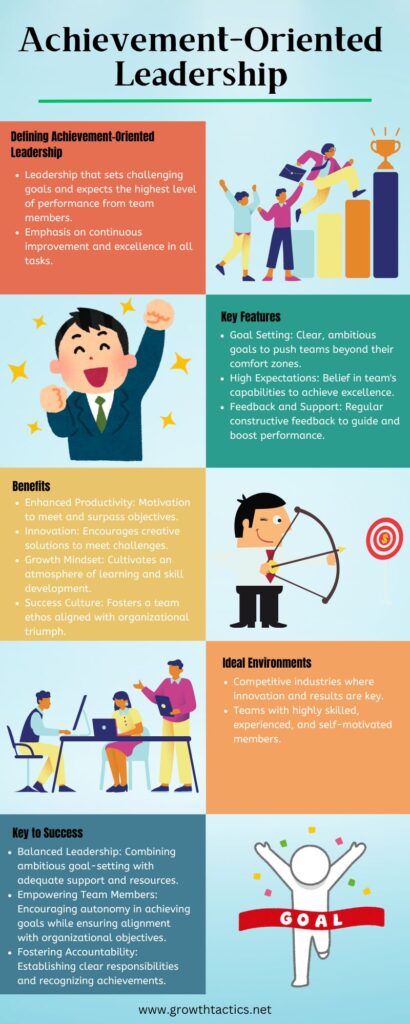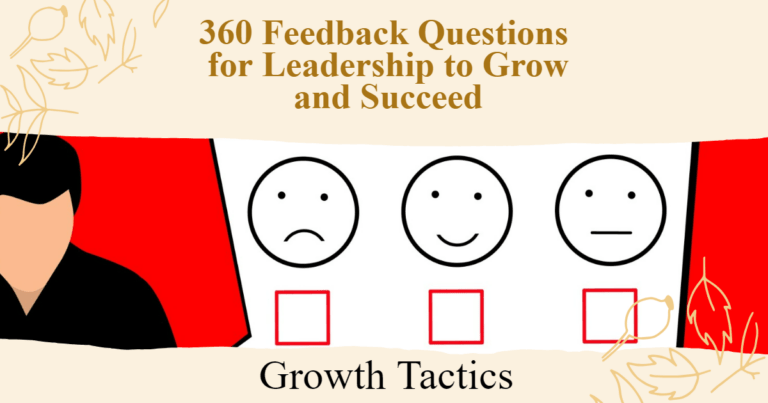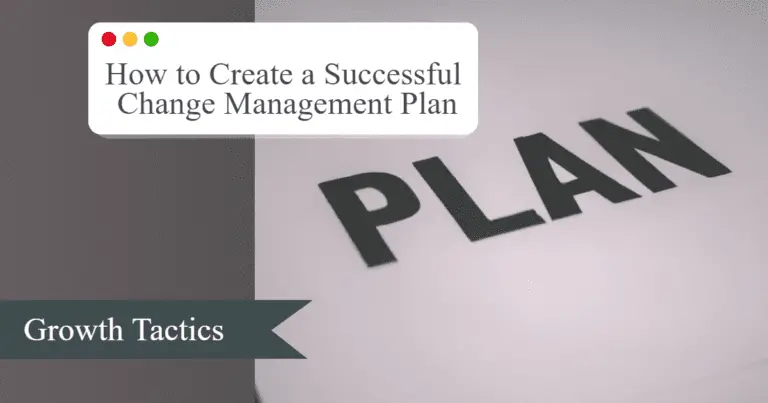Want to unlock your team’s full potential? Embrace a leadership style that’s all about soaring ambitions and concrete results.
Achievement oriented leadership isn’t just a buzzword, it’s a proven catalyst for taking productivity to new heights. Simple to grasp yet powerful in action, this approach turns average into exceptional.
Throughout my career, I’ve implemented an achievement-oriented leadership approach to enhance my team’s performance and achieve ambitious targets.
Whether you’re leading a start-up or guiding a seasoned team, the secrets to greater success are within this strategy.
In this article, we’ll dive into compelling achievement oriented leadership examples that inspire, motivate, and deliver. Get ready to transform the way you lead!

Jump To Section
Understanding Achievement Oriented Leadership
The achievement oriented type of leadership focuses on setting high goals. Aim higher and push the team to its limits. Leaders adopting this style don’t settle for mediocrity; they chase greatness.
In this model, leaders have a deep belief in their team’s potential. They see the power of challenging yet achievable objectives. These leaders craft a vision that stretches beyond current achievements, inspiring everyone to reach new heights.
Clear communication is their forte. They clarify expectations, outlining precise goals and the paths to reach them. More than that, they walk alongside their team, offering guidance, support, and real-time feedback.
Such leadership doesn’t just aim for targets. It’s about creating an environment where everyone is motivated to grow and excel. Team members feel valued, knowing their hard work contributes to reaching bigger goals.
To sum up, achievement-oriented leadership is not just about outcomes; it’s about fostering a culture of ambition, growth, and continuous improvement. It’s a way to bring out the best in teams by pushing boundaries and celebrating the journey towards achieving remarkable things.
The Benefits of Achievement-Oriented Leadership

Adopting an achievement-oriented style of leadership can transform teams and elevate performance. Here’s how:
- Boosts Motivation: Setting high goals inspires the team. It gives everyone a challenging yet exciting target to aim for.
- Enhances Performance: When expectations are clear and ambitious, team members push themselves harder. This drive improves overall team performance.
- Fosters Skill Development: Achieving tough goals requires learning new skills. This leadership style promotes continuous personal and professional growth.
- Improves Problem-Solving: High aims bring complex challenges. Teams learn to innovate and find creative solutions together.
- Increases Employee Satisfaction: Reaching ambitious goals is satisfying. It boosts team morale and individual confidence.
- Creates a Positive Work Culture: Achievement orientation leads to a culture of excellence. Everyone strives to do their best, creating a dynamic and positive work environment.
- Drives Results: Ultimately, this leadership style is about achieving outstanding outcomes. Teams under achievement-oriented leaders often outperform their counterparts.
In short, achievement-oriented leadership is not just good for business; it’s good for everyone involved. It turns challenges into opportunities for growth, pushing teams to achieve more than they thought possible.
Key Strategies Employed by Achievement-Oriented Leaders
Achievement-oriented leaders leverage powerful tactics to guide their teams toward higher performance. Here’s a deeper dive into each strategy:
Set Clear, Ambitious Goals
Leaders set specific, challenging objectives that push the team beyond their comfort zones. These challenging goals are designed to be attainable yet ambitious, ensuring that team members have a clear target to strive for.
By setting high standards, leaders instill a sense of purpose and direction, making it clear what success looks like. This strategy not only motivates the team but also fosters a culture of excellence and continuous improvement.
Provide Continuous Feedback
Ongoing, constructive feedback is crucial for team growth and development. Achievement-oriented leaders regularly assess individual and team performance, offering insights that help identify both strengths and areas for improvement.
This system of feedback ensures that team members remain aligned with the overall goals and are consistently improving their skills and work quality. Such an approach builds a supportive environment where constructive criticism is valued as a tool for personal and professional growth.
I utilize feedback sessions to reinforce the strengths of my team members while also addressing areas where they can improve. I value making these sessions interactive and encouraging a two-way dialogue to maximize their effectiveness.
Encourage Autonomy
Trusting team members to manage their responsibilities empowers them and fosters a sense of ownership over their work, motivating employees. Leaders provide the necessary guidance and support but encourage individuals to take the initiative.
This empowerment leads to greater job satisfaction and innovation, as team members feel confident to explore new ideas and approaches. Autonomy also allows leaders to focus on strategic planning and confidence in their team’s ability to handle operational tasks effectively.
Not all employees are capable of being completely autonomous but when I find the right ones they help lighten my load. This allows me to focus on more important tasks.
Recognize Efforts and Accomplishments
Acknowledging and celebrating the achievements of individuals and the team as a whole is a key motivator. Recognition can range from a simple thank you to more formal rewards.
Achievement-oriented leaders understand the power of appreciation in building morale and encouraging further efforts. Celebrating milestones and successes fosters a positive work environment and reinforces the behavior and work ethic needed for future achievements.
This approach also improves the delivery of constructive feedback. Becoming a leader who only focuses on areas of improvement can lead employees to disengage and hinder their chances of success.
Foster a Collaborative Environment
Collaboration is essential for leveraging the diverse skills and perspectives within a team. Leaders encourage open communication and teamwork, creating opportunities for members to learn from each other and work effectively toward common goals.
This collaborative mindset breaks down silos, facilitates innovation, and ensures that all team members feel valued and understood. It’s through this collective effort that complex problems are solved more creatively and efficiently.
Offer Support and Resources
Ensuring that the team has access to the necessary tools, technology, and training is crucial for overcoming challenges and reaching goals. Leaders actively assess and address the needs of their team, whether that means providing additional resources or removing obstacles that hinder performance. This support not only equips the team to perform their tasks effectively but also signals the leader’s commitment to the team’s success.
Lead by Example
Leaders set the standard for dedication and hard work. By embodying the values and behaviors they wish to see in their team, achievement-oriented leaders inspire confidence and respect.
This example-setting goes beyond simple directives; it’s about demonstrating commitment through actions, whether that’s staying late to meet a deadline or showing resilience in the face of setbacks. A leader’s actions can powerfully motivate the team and establish a culture of accountability and excellence.
Encourage Risk-Taking
Innovation often requires stepping out of comfort zones. Leaders who encourage calculated risk-taking foster a culture where creativity and innovation thrive.
By valuing experimentation and learning from failure, these leaders create an environment where team members are not afraid to try new approaches. This openness to risk is not about recklessness but about recognizing that some of the greatest advancements come from learning through trial and error.
Adapt and Adjust
The ability to flexibly adjust strategies based on feedback and outcomes is a hallmark of achievement-oriented leadership. Leaders closely monitor progress and are prepared to pivot tactics to better align with evolving goals or unexpected challenges.
This agility prevents stagnation and ensures that the team remains on the most effective path to success. By constantly evaluating and adapting, leaders can sustain momentum and drive continuous improvement.
These strategies collectively create a dynamic and engaging work environment where teams are motivated to achieve their best. Achievement-oriented leaders, through their actions and decisions, cultivate a culture of excellence and relentless pursuit of goals.
Examples of Achievement Oriented Leadership in Practice
Achievement-oriented leadership pushes boundaries and garners results. Here’s how leaders put this approach into practice.
Big Tech Innovations
Consider tech giants like Apple and Google. They thrive on setting audacious goals. Apple consistently aims for revolutionary products. Google grants employees “20% time” to pursue innovative projects. Goals are clear. Expectations are high. Both companies encourage risk-taking and autonomy, fostering industry-leading innovations.
Sports Coaching Strategies
Elite sports coaches embody achievement orientation. They set exacting standards and detailed performance metrics. Athletes receive continuous feedback to improve their skills. Coaches recognize and celebrate every win. They adapt training methods based on each game’s outcome. Team dynamics revolve around mutual respect and collaboration.
Education Reforms
Educational leaders also embrace this style. They introduce bold reforms and challenging curricula. Continuous assessment of both teachers and students ensures aligned learning goals. Autonomy is vital. Educators customize teaching strategies. Success gets recognized at assemblies and through accolades. Innovative teaching methods are encouraged and shared.
Global Health Initiatives
Leaders in global health set lofty aims to tackle substantial challenges. They mobilize resources and expertise toward common targets like eradicating diseases. They adapt strategies in response to data and outbreaks. Collaborative efforts unite governments, NGOs, and communities. Regular feedback loops and recognition sustain momentum.
Start-Up Growth
In start-ups, achievement-oriented leadership is almost a requirement. Founders aim high, pursuing disruptive ideas. They adapt quickly to market reactions. Autonomy is a given—teams must move fast and make independent decisions. Start-ups celebrate milestones frequently. They pivot as needed, learning from failures without losing sight of their vision.
Each example showcases leadership that is decisive, adaptive, and inspirational. These leaders challenge, support, and celebrate their teams. They transform ambitious goals into concrete achievements.
Advantages and Disadvantages of Achievement Oriented Leadership
Achievement-oriented leadership can drive teams to excel, yet like any style, it comes with both pros and cons. Here are the main advantages and disadvantages organized in bullet points:
Advantages
- Boosts Performance: This leadership style sets high standards, pushing teams to perform at their peak. It emphasizes growth and exceptional outcomes.
- Clarifies Objectives: Leaders provide crystal-clear goals. Teams know exactly what to achieve, reducing ambiguity and enhancing focus.
- Promotes Professional Growth: Continuous feedback fosters individual improvement, helping everyone understand their strengths and areas for development.
- Increases Innovation: Encouraging autonomy allows creativity to flourish. Team members can propose and implement innovative ideas.
- Recognizes Success: Celebrating achievements builds morale. Recognized individuals feel valued and motivated to contribute further.
- Encourages Ownership: By trusting team members to make decisions, leaders instill a sense of ownership, empowering them and boosting engagement.
Disadvantages
- Risks Burnout: Constant high performance can lead to stress and burnout, not all team members can sustain high pressure.
- May Overlook Work-Life Balance: Sometimes, achievement-focused leaders prioritize results over work-life balance, which can harm well-being.
- Can Create Pressure: High expectations might create a pressured environment, making some feel overwhelmed instead of motivated.
- Requires Resource Availability: This style depends on adequate resources. Without them, teams may face frustration and failure.
- Could Foster Competition: Though competition can be healthy, it might pit team members against each other, damaging collaboration.
- Might Ignore Long-term Development: Focus on immediate results can overshadow long-term growth and learning opportunities, especially if risks lead to setbacks.
In summary, achievement-oriented leadership can propel teams to new heights. However, leaders must balance ambition with the team’s well-being and sustainable growth to ensure long-term success.
Concluding Thoughts
Achievement-oriented leadership has clear benefits, challenging teams to achieve their best. However, it’s crucial to maintain balance, ensuring individual well-being and team harmony. Leaders and organizations should reflect on their current leadership approaches. Incorporating achievement-oriented practices may offer a path to enhanced success and innovation. It’s about finding the right mix that propels teams forward while supporting their growth and well-being.








